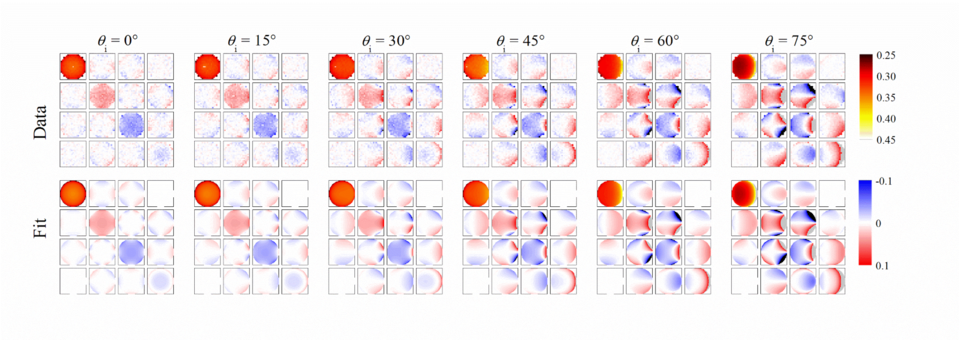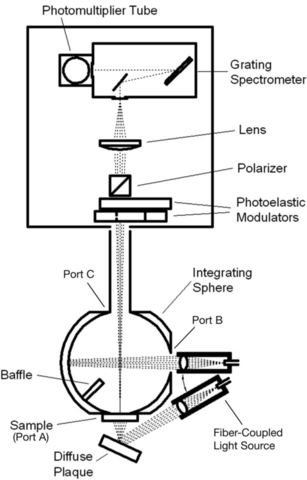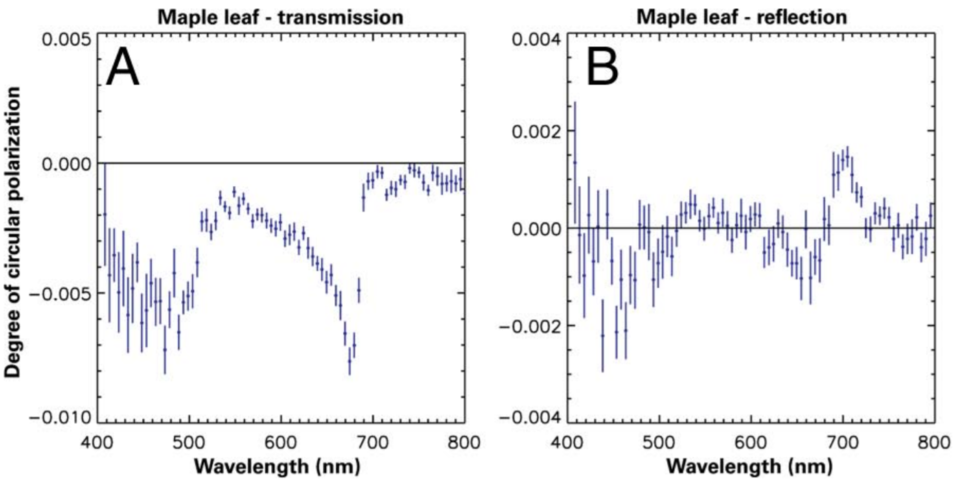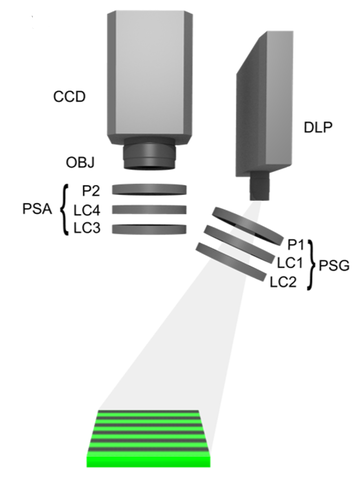Summary
This program aims to improve the metrology of optical polarization by developing new measurement methods and theoretical understanding of polarization phenomena.
Description
Electromagnetic waves are transverse. That is, besides propagating energy, they also have polarization represented by the direction of the electric field, which is constrained to lie in the plane perpendicular to the direction of propagation. Light rays can be characterized by a four-element Stokes vector, where one element is the energy-like quantity (e.g., power, irradiance, or radiance) and the other three provide information about the polarization. The relationship between an ingoing and an outgoing ray (e.g., reflectance or transmittance) is characterized by a 16-element Mueller matrix, giving a material up to fifteen more degrees of freedom than that with intensity alone. In many radiometric applications, this polarization information is ignored. However, polarization carries information about the source and all the materials that it has interacted with. The various aspects of this program are designed to measure and exploit this information.
Collaborations
We actively collaborate with outside researchers and encourage anyone interested in developing collaborative research projects to contact us. In addition, we encourage applications to the NIST-NRC Postdoctoctoral Research Associateships Program.
Polarized Optical Scatter Measurements
The Goniometric Optical Scatter Instrument (GOSI) can measure the Mueller matrix bidirectional reflectance distribution function (BRDF) of materials over a range of laser wavelengths. As an example, the figure below shows the Mueller matrix BRDF for a white diffuse reflectance standard as a function of incident angle, along with a fit to a phenomenological model. With this information, one can estimate the BRDF for any geometry and incident polarization state for this sample. Other applications include discrimination between different scattering mechanisms, such as roughness, volume scattering, or particles.

Theory of Polarized Light
How the polarization of light evolves as it propagates through media is important for understanding polarization phenomena. We perform a variety of theoretical studies that help us and other interpret polarization data:
- Modeling polarized light scattering from different types of media.
- Understanding the evolution of depolarization in diffuse media.
- Developing and distributing software tools for light scattering from materials and polarization phenomena (see SCATMECH, MIST, and pySCATMECH).
Circular Polarization as a Biosignature

One of the characteristics of life on Earth is that most of the complex molecules making it up exhibit homochirality: they have a unique handedness and appear different when viewed in a mirror. For example, most of the amino acids important for life are left-handed, while most sugars are right-handed. The functionality of these molecules, especially when combined into macromolecules (proteins, nucleic acids, and carbohydrates), differ from those with opposite handedness. The self-replicating feature of life has resulted in the DNA of every organism, from bacteria to humans, being a right-handed double helix. Even macro-structures can exhibit such homochirality, for example the conch shell or the asymmetry of human organs. In contrast, naturally occurring inorganic synthesis tends to create racemic mixtures of chiral molecules.
We are investigating how homochirality imparts itself onto the handedness of light. An imbalance in the degree of circular polarization, especially when correlated with a spectroscopic feature, may indicate the presence of life on a distant planet. We have a spectropolarimeter that is optimized for measuring degree of circular polarization with a sensitivity better than 0.0001. We have used this instrument to measure reflecting and transmitting polarization from samples, ranging from light harvesting bacteria to leaves.

Spatial Frequency Domain Mueller Matrix Imaging

There is quite a bit of interest in using polarization imaging techniques for biomedical imaging. Mueller matrix imaging can be sensitive to tissue structure alignment, which is sometimes destroyed by disease. Polarized light imaging of diffuse tissues, however, is sometimes dominated by deep tissue depolarization. We are investigating a novel combination of two techniques, spatial frequency imaging and Mueller matrix imaging, to potentially improve the sensitivity of polarized imaging to near surface features.
In spatial frequency domain imaging, a sinusoidal pattern is projected onto a specimen and images are taken as the phase of the pattern is varied. At each pixel in the image, the amplitude of the modulation is recorded. In this way, only short photon paths are sensed, yielding information about near surface features, even when an image from the uniformly illuminated specimen would be otherwise dominated by deeply penetrating photon paths. In Mueller matrix imaging, the polarization state of the incident radiation and the polarization sensitivity of the imager are modulated yielding the Mueller matrix image, which is sensitive to structure alignment. Both imaging modalities have been shown to have applications in biomedical imaging, where structure alignment in near-surface tissues can differentiate healthy from diseased tissue. In this project, we are investigating a combination of these two imaging modalities, increasing the alignment sensitivity to the near surface region.

